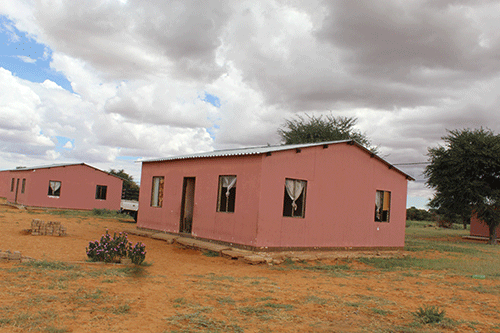CORRIDOR 17 – Developmental projects meant for the !Xoo San community in Corridor 17 have turned into white elephants, after the energetic !Xoo Traditional Authority chief Sofia Jakob died nearly a decade ago.
The government established, among others, a sewing project equipped with modern sewing machines and other equipment, 10 houses and a school in that area.
The !Xoo who spoke to New Era during a trip to observe their living conditions and the state of development in the Aminuis constituency, Omaheke region recently, indicated that since the passing of their queen in 2014, officials assigned to deal with their issues have not visited them.
“The government has contracted 10 houses out of the initial 20 promised. However, those houses are not yet completed. That is why they are not occupied,” said Beatrix Martins.
She said the half-built houses were constructed in 2014 and to date have water, toilets and windows.
“Those houses are incomplete. Who wants to occupy an incomplete house? A house without a toilet? you can be inside but you have to walk a distance to go to the bush at night. We rather stay in our bushes where we don’t need to walk a distance at night to relieve ourselves. The government has neglected us,” she explained.
They also claimed that government promised several projects when their late queen was alive, however, after she passed, the projects were put on hold.
“Imagine just after her passing those houses were abandoned. The school is also abandoned because there is no borehole which was supposed to ensure the water is sufficient for the hostel and the entire community. The clinic that was promised was never built,” they claimed.
Another resident, Magdalena Martins also claimed that the recognised chief who took over from the late Jakob does not fight for them as he does not stay in Corridor 17.
“Imagine everything is falling apart here, including the damaged cemetery fence. We have no one to fight for us. The government has forgotten us completely, we are on our own,” said Martins.
Martins explained that the needlework project came to a standstill due to the mismanagement of funds as the chief is absent from the area.
The group that spoke to New Era also alleged that they no longer receive drought relief food on time as was the case in the past.
“We use to get food from the government on time every month, but now two to three months can pass without receiving food,” they complained.
The government confirmed that they only distribute food quarterly as the budget is insufficient.
“The ministry provided supplementary food items to the marginalised communities in 10 regions, procured from the appropriation budget. The available budget is only sufficient to provide food four times each year and the ministry has distributed the supplementary food across the four quarters, meaning every three months. The communities are, therefore, encouraged to produce their food to improve sustainability,” said the poverty eradication and social welfare ministry’s spokesperson Lukas Haufiku.
Constituency councillor Peter Kazongominja said when he took over, he found everything at a standstill.
“I don’t know how this project was started, however, based on the secondary information at my disposal, the needlework project was halted due to mismanagement of funds,” he explained.
Haufiku said the ministry was not involved or consulted on the sewing project and thus does not know the responsible agent.
“However, the ministry will consult the communities at Corridor 17 to find an amicable solution meant to revive the sewing project. It will also assist the community by making sure that governance structures are put in place with proper reporting mechanisms to guarantee that the project is sustainable,” he said.
On the houses, he said he is trying to get to the bottom of the matter as he already found them constructed, and left with no occupation.
When this paper visited the houses, we learned that only one house was occupied.
Kazongominja also could not establish the amount of money pumped into the project that is now abandoned.
Contacted for comment, the directorate of the marginalised community explained that the housing project was the responsibility of the division of marginalised communities. While the sewing project was done under the auspices of a certain fishing company (name unknown) without the involvement of the division.
Tracing the fishing company that left the houses incomplete proved difficult as there is no clue to who they are so far.
“The construction of the housing structures was based on a community-centred approach. This means the community members selected a certain group that was responsible for making bricks and assisting with the construction afterwards. Each house was estimated to cost not more than N$100 000 inclusive of material and labour costs,” said Haufiku.
He added that the need and demand for housing provision among the marginalised (San, Ovatue and Ovatjimba) communities in 10 regions, unfortunately, surpasses the available budget.
“The ministry is currently consulting various stakeholders involved in the low-cost housing programmes to find an amicable solution and affordable model,” he said.


